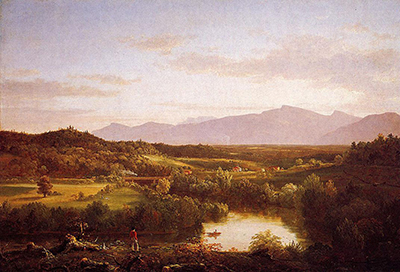River in the Catskills was painted by Thomas Cole in 1843. Cole was an American born in London, with this painting showing signs of English inspiration. Most of the English paintings during this period would capture the picturesque scenery found in nature, see Turner and Constable for example.
In this painting, Cole depicts a serene pastoral world that sets itself apart from the modernization taking place around it. While it depicts an ideal pastoral world, the inclusion of a steam locomotive highlights the antipastoral views that Thomas Cole had. This piece is also regarded as the earliest oil painting in America to depict a locomotive. While this painting was not commissioned, it stands out as one of the famous paintings of natural scenery and landscapes of Catskills by Thomas Cole.
Thomas Cole is renowned in his writings for his views on the destructive nature that comes with industrial development. During the Industrial Revolution, Cole and his contemporaries witnessed how industrialization was transforming their world both in a positive and negative manner. While industrialization was viewed as a necessary path to progress, it also had its issues. One such as major issue was the way it was interfering with nature. This can be considered one of the main reasons Cole pits pastoral activities such as lush greenery, livestock and pasture, against the effects of industrialization such as destruction of nature. The inclusion of a locomotive in this piece led to historian Alan Wallach describing the River in the Catskills painting as antipastoral.
Thomas Cole had extensively travelled through the Hudson Valley, before eventually settling in Catskills with his wife in 1836. The town was a major shipping port. While there, Cole witnessed its rise and decline over the years. The town ultimately ended with an unfinished railroad as a result of money squandering and local conflicts. This led to residents worrying about the destruction of their much treasured natural scenery. This led to Cole painting these landscapes to either make a statement against what he was witnessing, or as a historical preservation of how the scenery looked like before it was altered to accommodate modernization.
Unlike other of his previous works, this painting seems to highlight the extent that industrialization is having on the town. For example, there is limited use of the lush greenery in the composition. There is also a train, houses and smoke, which shows how fast civilization is encroaching the town of Catskills. In this composition, a man with a red coat is standing on the foreground with an axe and fallen trees around. The man is looking at the direction of the river, which meanders to the view of modernization where we see the houses and train. As he looks in that direction, one cannot help but wonder if he is pondering whether modernization has to result in destruction of nature.




